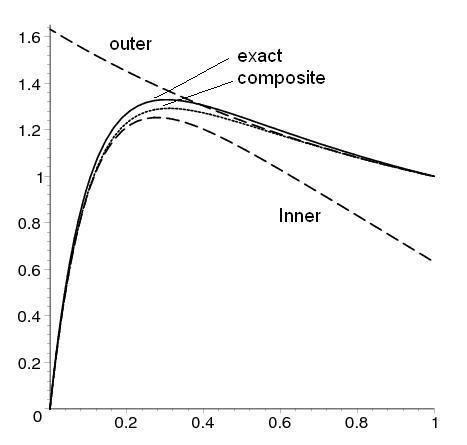 | ||
In mathematics, a singular perturbation problem is a problem containing a small parameter that cannot be approximated by setting the parameter value to zero. More precisely, the solution cannot be uniformly approximated by an asymptotic expansion
Contents
- Methods of analysis
- Examples of singular perturbative problems
- Vanishing coefficients in ordinary differential equations
- Examples in time
- Examples in space
- Algebraic equations
- References
as
Methods of analysis
A perturbed problem whose solution can be approximated on the whole problem domain, whether space or time, by a single asymptotic expansion has a regular perturbation. Most often in applications, an acceptable approximation to a regularly perturbed problem is found by simply replacing the small parameter
Singular perturbation theory is a rich and ongoing area of exploration for mathematicians, physicists, and other researchers. The methods used to tackle problems in this field are many. The more basic of these include the method of matched asymptotic expansions and WKB approximation for spatial problems, and in time, the Poincaré-Lindstedt method, the method of multiple scales and periodic averaging.
For books on singular perturbation in ODE and PDE's, see for example Holmes, Introduction to Perturbation Methods, Hinch, Perturbation methods or Bender and Orszag, Advanced Mathematical Methods for Scientists and Engineers.
Examples of singular perturbative problems
Each of the examples described below shows how a naive perturbation analysis, which assumes that the problem is regular instead of singular, will fail. Some show how the problem may be solved by more sophisticated singular methods.
Vanishing coefficients in ordinary differential equations
Differential equations that contain a small parameter that premultiplies the highest order term typically exhibit boundary layers, so that the solution evolves in two different scales. For example, consider the boundary value problem
Its solution when
Examples in time
An electrically driven robot manipulator can have slower mechanical dynamics and faster electrical dynamics, thus exhibiting two time scales. In such cases, we can divide the system into two subsystems, one corresponding to faster dynamics and other corresponding to slower dynamics, and then design controllers for each one of them separately. Through a singular perturbation technique, we can make these two subsystems independent of each other, thereby simplifying the control problem.
Consider a class of system described by following set of equations:
with
on some interval of time and that, as
Examples in space
In fluid mechanics, the properties of a slightly viscous fluid are dramatically different outside and inside a narrow boundary layer. Thus the fluid exhibits multiple spatial scales.
Reaction-diffusion systems in which one reagent diffuses much more slowly than another can form spatial patterns marked by areas where a reagent exists, and areas where it does not, with sharp transitions between them. In ecology, predator-prey models such as
where
Algebraic equations
Consider the problem of finding all roots of the polynomial
in the equation and equating equal powers of
To find the other root, singular perturbation analysis must be used. We must then deal with the fact that the equation degenerates into a quadratic when we let
We can see that for
Substituting the perturbation series:
yields:
We're then interested in the root at
